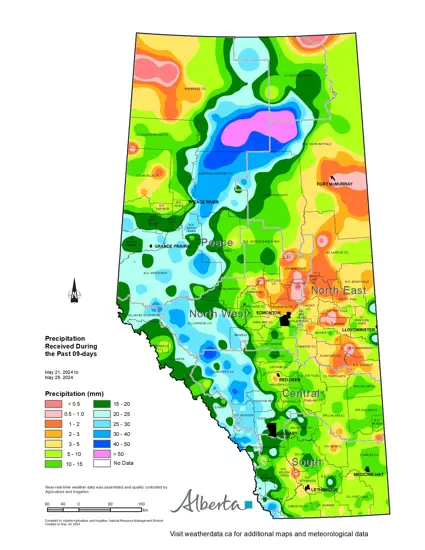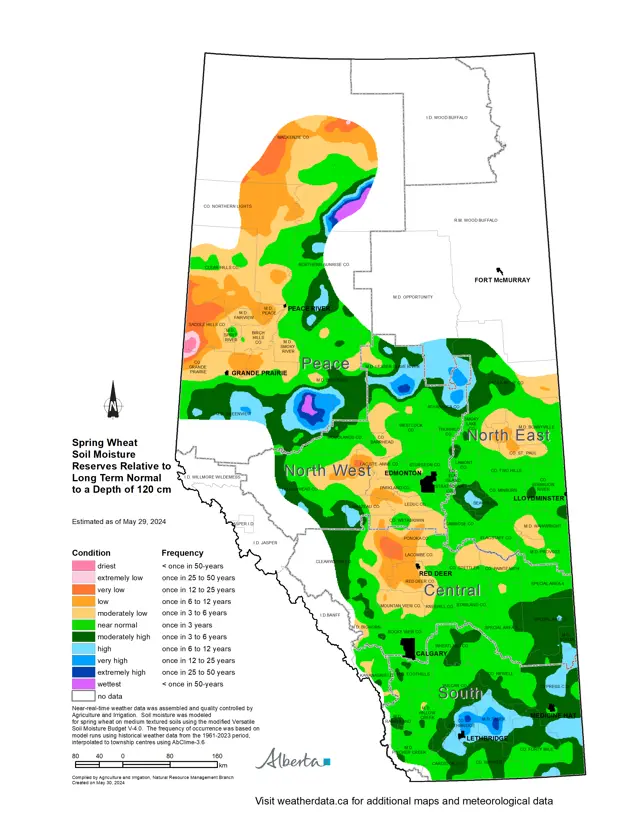Moisture Update - May 29, 2024

Synopsis
Map 1: In the last 9-days since May 20, rainfall has been variable (Map 1), ranging from over 50 mm across the North Central Boreal Forests, concentrated in the Birch Hills area, to less than 1 mm through parts of the Peace and North East Regions.
As of May 30, the Piccadilly Auto Station received 136 mm (unverified), followed by the Enda Auto Station with 129 mm (unverified), both located in the Birch Hills area. Other areas that received good moisture in recent days, included much of the eastern Peace Region, at >40 mm, and many lands across the southern Peace Region, at over 20 mm. This large band of moisture extended south all the way to the US border, but was generally confined to the mountains and foothills, with totals ranging from 20 to 50 mm. Elsewhere most of the moisture was relatively hit and miss, driven by bands of thunderstorms that moved across the province. In contrast, much of the North East remained dry, allowing seeding to progress following the previously generous rains. Unfortunately, some areas of the Peace Region and extreme northern portions of the province, remained very dry following several months of well below normal precipitation.
30-Day Precipitation Trends
Maps 2 & 3: Over the past 30-days, welcome and unusually wet weather has returned to much of the east-half of the province (Map 2), holding the drought of 2023 at bay, with the result of vast improvements in soil moisture reserves. The east-half of the province sees a May this wet less than once in 6 to 12 years, with several pockets seeing this much rain on average less than once in 50-years.
For the most part, rainfall has been at least near-normal across most areas of the province, with a few holdouts of below normal moisture across the Peace Region and through small isolated pockets in the North West, centered on Mayerthorpe and Dickson Dam in the Central Region (Map 2). Total precipitation accumulations over the last 30-days are highly variable, ranging from well over 200 mm at many widely scattered stations, to less than 15 mm through some of the northern parts of the province (Map 3).
Unusually wet areas worth mentioning include lands around Lethbridge and Medicine Hat, where more than 120 mm has fallen, the Special Areas where 80 mm or more has fallen in several locations, and also through parts of the North East, where more than 100 mm has fallen. Similarly, across the mountains, foothills, the Swan Hills, and north-central portions of the Boreal Forest, many stations have reported well over 100 mm. In sharp contrast, the western-half of the Peace Region is still very dry, with many areas receiving less than 40 mm in 30-days, following a very dry winter. Parts of the North West Region and a dry corridor through the west central parts of the Central Region have struggled to receive more than 40 mm, which is about 25 mm below average for this time of year. Normally this would not be a concern, but a warm, dry fall and chronic lack of over winter moisture, along with several mid-winter snow melt episodes, has left much of the land quite dry and in desperate need of spring moisture. Fortunately, June is historically the wettest month of the year, and above average moisture has been making its way into many parts of the province. This has left several large areas with a moist land surface that may help to bolster storm activity and bring moisture in to some of the areas that need it most.

Soil Moisture Reserves
Map 4: Soil moisture reserves are recovering across most of the province, with large parts of the Southern Region and parts of the Special Areas now trending to above normal for this time of year (Map 4). Below normal reserves are still persisting through some of the western sections of the Central and North West Regions, along with isolated pockets in the North East Region. Significantly, large parts of the Peace Region are still well below normal for this time of year, with a pocket of once in 50-year lows still holding out in Saddle Hills County, located northwest of Grande Prairie.

Perspective
Map 5: So far, 2024 has marked a dramatic turnaround in drought conditions across most of the province. In addition, the wet season still lies ahead of us and there is ample opportunity to receive further moisture if the current weather patterns hold. Across the Peace Region, the wet season typically gets underway in the latter half of May and peaks throughout June and July (Map 5). In recent days, we have seen moisture start to build across parts of the Peace Region, and hopefully this is a good sign that wetter, more normal weather patterns are on their way.
With persistent rains across the south and a relatively wet land surface, the potential for large damaging thunderstorms has increased, particularly if it turns hot and humid in the coming days and weeks.
Contact Us
Saddle Hills
Junction of Hwy 49 & Secondary Hwy 725
RR1, Spirit River AB
T0H 3G0
T. 780-864-3760
Fax 780-864-3904
Toll-free 1-888-864-3760
frontdesk@saddlehills.ab.ca
Sign up to our Newsletter
Stay up to date on the Saddle Hills activities, events, programs and operations by subscribing to our eNewsletters.


